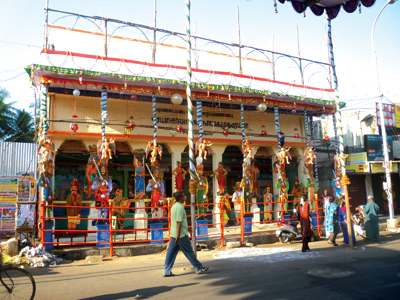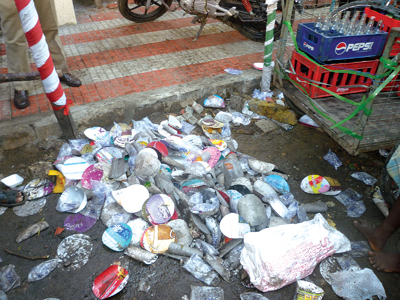
|

|
|
This is the Bommai Chattiram on South Mada Street, all decked up for the Mylapore Festival... |
... But this is what many areas in the Mada Streets are like during the Festival. |
The annual festival of the Mylapore Kapaleeswarar Temple has just concluded. It was a grand spectacle, in keeping with what is expected of a tradition that has spanned several centuries. The devout and the curious assembled in the thousands and were not disappointed. It was a gala ten days, except for the woeful inadequacy it exposed – both in terms of civic infrastructure and the sense of civic discipline in the public. This is not the first time this has happened and, as the years advance, the pressure is only building up on what little amenities that are available.
Take, for instance, the traffic. Given that the festival happens each year and its dates are fixed pretty much in advance, surely the city's traffic police can involve themselves in some creative solutions. One of these could be the declaration of the four Mada Streets as 'pedestrian only' zones at least for the ten days of the festival. Residents with vehicles could be given entry passes, surely not a difficulty in this electronic age, and the rest could be asked to park their vehicles at specific locations and walk the rest of the distance. And for those who cannot walk, the temple, given its substantial income, can even think of running a ferry service comprising the kind of golf carts that are in use at the Madurai Meenakshi temple and also at Central Station. This will work. very well, especially if other kinds of traffic are prevented from entering the zone during the festival.
What is happening at present is that the traffic is allowed to flow right through the four streets whenever the deities are not being taken out in procession. What is overlooked is that the festival becomes an occasion when vendors of traditional wares such as pottery, woodcraft and metalwork, display and sell them on the footpaths and the streets. This further constricts the already narrow streets and makes the movement of traffic all the more difficult. The erecting of temporary pavilions to shelter the deities all along the processional route further compounds the problem. The best solution would be to suspend all traffic movements for ten days. It will only enhance the festive feel. But, if this cannot be implemented, can we at least declare the four streets to be 'no horn' zones during the festival. There are some drivers who hoot even at the deities, hoping that the procession would speed up!
One of the most endearing features of this festival is the tanneer pandal, or refreshment stall, which is put up to dispense water and some eatables to those who visit the festival. These being times of relative prosperity, these pandals have rapidly increased in number. They have also begun distributing all kinds of cooked preparations. Political parties have also jumped in, no matter what be their outlook on religion. As a consequence, there is a surplus of food available. The visiting public simply grabs at everything that is offered and then just discards what it does not want. This leads to an enormous waste of food, all of which lies about on the road and gets trampled upon. The Corporation increases the frequency of cleaning up during the ten days, but when the litter is thrown about with no consideration or thought for cleanliness, there is very little that can be done even with frequent cleaning up. What is needed is a larger number of temporary dustbins and strict instructions to those who man the tanneer pandals that they will be responsible for the cleanliness in their vicinity.
Would it be too much to expect temporary public conveniences? These are not all that much of a novelty, for during the Tamil Conference in Coimbatore a few years ago, public hygiene was maintained by pressing into service these portable units that provide complete privacy, are easy to clean and transport. Surely, Chennai can take a leaf out of Coimbatore's book? It is indeed a sorry sight to see men relieving themselves along a processional route down which deities are being brought.
That said, it is congratulations to the temple authorities, the police and the Corporation for successfully handling what is increasingly a logistic challenge. But given that cleanliness is said to be next to godliness, can we hope for both?
Who knows all about heritage buildings?
(By The Editor)
We heard it said the other day that the Indian National Trust for Art and Cultural Heritage's Chennai Chapter knows nothing about heritage buildings. That the architects, history and heritage buffs, story-tellers and dilettantes associated with INTACH-Chennai know nothing about heritage buildings. We also heard it said that the experts on the subject were institutions like the Heritage Conservation Committee of the Chennai Metropolitan Development Authority, the Corporation of Chennai, Metrorail, Government Infrastructure organisations, etc. with their complement of bureaucrats, engineers and planners.
Now that it has been stated definitely that those associated with these Government organisations are experts on heritage buildings, may we, and others like us, appeal to them to draw up a Heritage Act worthy of a city of the 21st Century as quickly as possible and have it enacted. To take the first step of drawing up the Act, they won't have to do much. A draft was suggested to the States by a Central Ministry more than a decade ago and it was fine-tuned by various Tamil Nadu bureaucrats at different times, but never seemed close to presentation for enactment. With their expertise attested to, perhaps the present group of bureaucrats, engineers etc. will fine-tune the draft a little more, spell out in one-syllable words what heritage buildings are, and have the Act enacted.
West Bengal has a Heritage Commission Act for the whole State. Mumbai, Kolkata and Hyderabad have legislation protecting identified heritage buildings. Delhi and Bangalore have their Urban Arts Commissions. But why do we want to be like them? We always want to be like that 21st Century city, Singapore. So, perhaps then, this now-certified team of experts should visit Singapore and see what its rigorous Heritage Act has done to areas with Chinese, Malay, Indian and Colonial Heritage. Perhaps they should look at what has been done there being done to George Town, the Mada Streets of Mylapore and Triplicane, Rajaji Salai and the Marina, and several other heritage precincts in Chennai (not to mention elsewhere in Tamil Nadu).
We are quite sure that all those members of INTACH-Chennai who know nothing about heritage buildings will be only too glad if the now-proclaimed experts draw up a Heritage Act – after visiting Singapore – and ensure that it is enacted. And implemented. That's all heritage buffs like your Editor want. And have wanted for over twenty years now.
|

